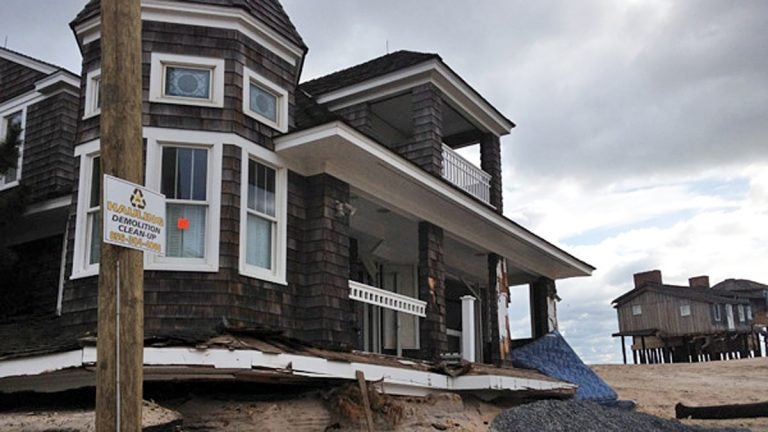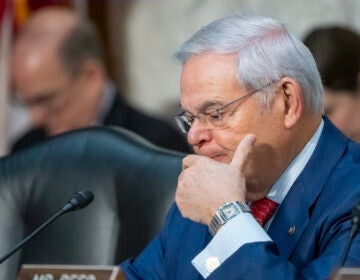N.J. submits plan to FEMA ahead of publicly announced comment period

(Photo courtesy of NJ Spotlight)
After coming under fire for a lack of transparency in how he’s handled the Sandy recovery, Gov. Chris Christie has gone back to the town-hall circuit in recent weeks, and members of his cabinet have been making more public appearances.
The administration has vowed to allow greater public input into its future plans. But that didn’t stop them from quietly submitting a report on hazard mitigation to the federal government last month, ahead of a publicized comment period for the same plan.
The move has angered planning advocates and environmentalists, who had hoped that their expertise and feedback from the public at large would have been given greater consideration before decisions were made.
The Hazard Mitigation Plan contains New Jersey’s assessments of the risks it faces and the steps it’s taking to minimize those risks. FEMA requires the state to update its plan every three years in order to be eligible for disaster recovery assistance and mitigation funding. That includes hundreds of millions of dollars New Jersey has earmarked for buyouts of flood-damaged properties, aid to help residents elevate their homes, and funding for backup generators, which is at the center of Hoboken Mayor Dawn Zimmer’s claim her city was shortchanged.
A few weeks ago, state officials released their final draft of the plan on the N.J. Office of Emergency Management’s website, and — for the first time ever — invited the public to chime in with their thoughts. They provided an email address and a link to an online survey where comments could be submitted for the next 30 days, concluding on April 11.
Opening Up the Process?Planning advocates were excited at the prospect. New Jersey Future, a group that promotes “responsible land-use policies,” issued a news release commending the state for opening up the process. “We have been requesting since last fall that the public be allowed to review a draft and are delighted that the public will now have this opportunity,” the release said, before urging people to submit their comments.
Other groups were also eager to have their say. The N.J. Chapter of the American Planning Association posted a notice on its website encouraging its members to participate in the comment period, and the American Littoral Society’s Tim Dillingham said his organization was looking forward to reviewing the plan in detail.
“Asking the public for their input is always valuable, and almost always results in better plans by government agencies. So it should be a standard practice,” he said. “The fact that it’s not and the fact that OEM invited the public to comment this time is indeed a good sign.”
But then the story began to change. OEM spokeswoman Mary Goepfert clarified a few days later that the plan will be submitted “before the public comment period concludes in order to meet a federal deadline.” In another interview, she said that that the comments received “will not have an impact on the currently proposed plan” but will instead be used to “help guide ensuing plans and the state’s response to future disasters.”
Her office had previously claimed in a news release that “This is the first time the NJ Office of Emergency Management has opened a public comment period before submitting the plan to the Federal Emergency Management Agency for approval,” but NJ Spotlight has since learned that the state actually submitted its plan on March 5, six days before the public comment period even began.
A Frustrating ExperienceSome of the same groups that had been excited at the prospect of having an opportunity to comment are now expressing their frustration.
“It’s a little absurd,” said Dillingham. “It was a good move to ask the public for their input, but it’s puzzling at best to understand why they would not include the consideration of those comments before they submit it to FEMA.”
State officials now say that New Jersey needed to submit this plan right away in order to meet a federal deadline. Though the existing plan doesn’t expire until the end of April, they said that they were required to turn in the new plan at least 45 days prior to that — by March 12 — and that FEMA had been requesting it since late February.
“The State requested additional time to submit the draft plan to Region II in order to accommodate a formal public comment period,” Goepfert said in a statement. “FEMA Region II advised that it did not have the discretion to grant the State an extension. Pursuant to the applicable statutory and regulatory requirements, the expiration date of state hazard mitigation plans cannot be extended under any circumstance,” she added.
Given the deadline, however, it’s unclear why the state didn’t simply start its public comment period earlier, so it could have incorporated any feedback it received before it turned the plan in.
While Dillingham was troubled by the turn of events, Chuck Latini — president of the NJ Chapter of the American Planning Association (APA) — was furious. He said that about a year ago, before state officials began the process of updating the Hazard Mitigation Plan, they had asked his group to prepare a white paper detailing its “gold standards” recommendations for how such a plan should be created. He said APA and other groups like NJ Future were promised that they’d be consulted throughout the process and would be given copies of early drafts before the process was complete.
“They were going to share this stuff with us,” he recalled. “That never happened. And not only did that not happen, but then they issue a plan, and they submit it, and we’re going to go through this sham of a public input process that’s not even going to have an effect on the plan, but might be considered for future storms or future plans?” he continued. “I don’t care about future plans, ’cause things change every day! This stuff needs to get evaluated more often than me providing comments today, and then maybe five years from now, you’re going to include it!”
He called the process “shameful” and added that he has little desire to “throw stones” at the plan after it’s already complete. State officials, he said, should have considered input from groups like his own during their process, even if they ultimately decided to ignore many of those suggestions.
In response to inquiries, the NJ Office of Emergency Management said that it would be postponing all interviews on the matter until after the comment period is over. “There have been some articles on this already written — negative, positive, and neutral,” Goepfert wrote in an email. “We are trying to avoid those who wish to comment being influenced by what they are reading, or maybe refraining from commenting based on what they read or hear in the news.”
She did release a statement, though, reiterating that that state would carefully review all comments it receives and modify the plan after the fact, as it saw fit. “FEMA encourages states to constantly evaluate their plans, and liberally allows amendments,” she said.
Making ModificationsIndeed, even though the plan only undergoes a complete update every three years, it’s true that amendments can be added between now and the next time it’s officially revised in 2017. The section on plan maintenance clarifies that state officials will meet twice a year to make any modifications deemed necessary. Critics counter that they have no assurances that their comments will be considered at a future date. And they say that if state officials were sincere in their desire for input, they would have found a way to incorporate that feedback into the current plan before turning it in. While FEMA doesn’t mandate that states hold public comment periods prior to adoption of their Hazard Mitigation Plans, it does require that they consult with “interested parties” while they’re in the process of formulating their plans.
And according to plan documents posted on OEM’s website, state officials did seek input from close to 20 different groups, including government bodies like the Port Authority of New York and New Jersey, the Army Corps of Engineers, and the Delaware River Basin Commission. There were also members of academia, including the Richard Stockton College Coastal Research Center and the Rutgers Climate Institute. And a few outside groups like the New Jersey League of Municipalities and the New Jersey Association for Floodplain Management.
But the overwhelming majority of these interested parties were state organizations or state universities, said NJ Future. “They’re important stakeholders, but they have a formal role,” said Chris Sturm, the group’s Senior Policy Director. She thinks that if NJ Future had been consulted throughout this process, it would have brought to the table a perspective she said state officials didn’t appear to fully consider, including a detailed examination of land use and growth patterns to try to guide future development away from the riskiest areas.
Ask the ExpertsChuck Latini with the American Planning Association agrees. “I’ve got 1,200 members, and of those members, there’s a bunch who are leading experts in this stuff. And [if] you’re not involving them, then you’re not taking advantage of the resources the state has to offer,” he said.
It’s unclear why groups like NJ Future and the Planning Association — which were knowledgeable and had volunteered to give input — wouldn’t have been included. Equally elusive: what the state’s criteria were for deciding with whom it should consult. In her statement, Goepfert simply suggested that the state chose to rely primarily on groups that had been involved with the formation of Hazard Mitigation Plans in the past. “No organizations have been formally excluded from the planning process,” she said.
David Kutner — who’s a Recovery Planning Manager at NJ Future — points to nearby states that have taken vastly different approaches from New Jersey in updating their Hazard Mitigation Plans. Maryland, for example, held a series of workshops and open houses aimed at trying to get input from entities and organizations outside of state government, he said. “They really reached out to the community to engage them.”
Likewise, emergency management officials in New York State held a lengthy public comment period on their website before their plan was finalized. But here in New Jersey, Kutner said, “that kind of effort is really absent at a state level.”
Scott Gurian is the Sandy Recovery Writer for NJ Spotlight, an independent online news service on issues critical to New Jersey, which makes its in-depth reporting available to NewsWorks.
This article was originally published on April 4, 2014.
WHYY is your source for fact-based, in-depth journalism and information. As a nonprofit organization, we rely on financial support from readers like you. Please give today.




